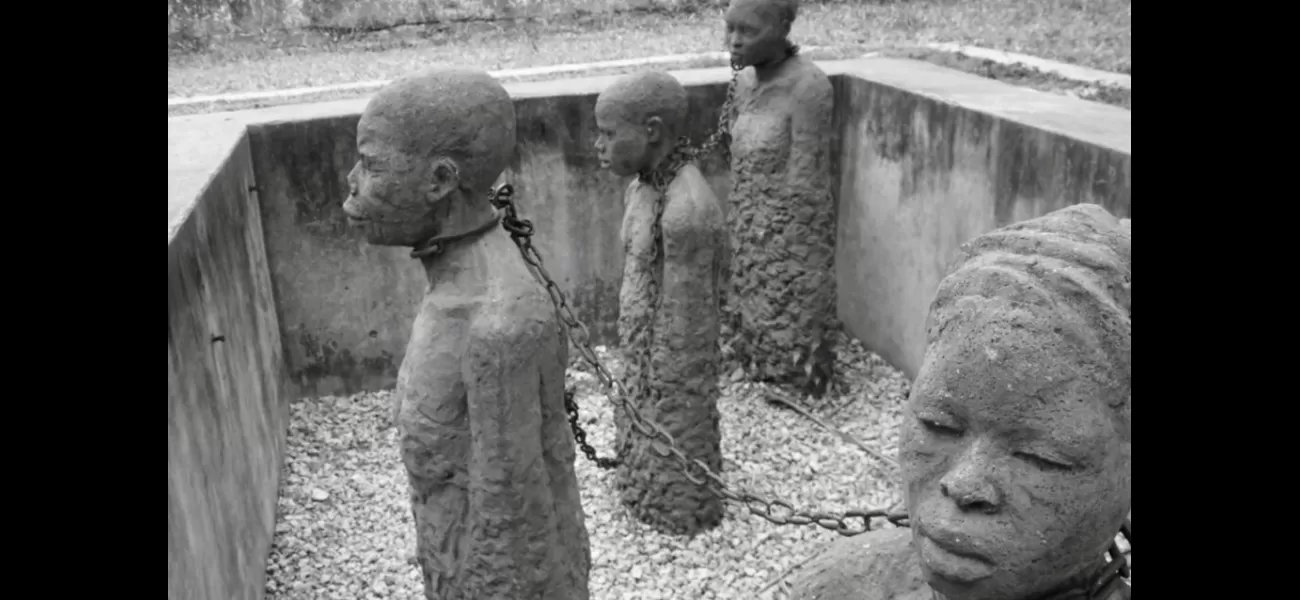In the past, enslaved Africans were treated as items to be bought and sold like insurance products.
On April 20, 1859, there was a devastating explosion at the Bright Hope Coal Pits in Chesterfield County, Virginia, causing widespread destruction.
June 25th 2024.

On April 20, 1859, the Bright Hope Coal Pits in Chesterfield County, Virginia was shaken by a terrible explosion. This tragic event claimed the lives of nine men, four of whom were white. The names of these men were solemnly printed in newspapers across the South, including Isaac Farmer, George Smith, Nicholas Blankenship, and Albert Rowe.
A dispatch from the Kanawha Valley Star reported the chaos and panic that ensued after the explosion. Despite every effort to rescue the men, it proved impossible due to the toxic gases that filled the shaft. It was believed that their bodies had been completely consumed in the blast.
Among the victims were also five Black males, whose names were not publicly recorded. They were labeled as "servants" in press accounts, but in reality, they were slaves owned by different white masters. Sadly, their deaths were only noted in terms of property loss. It was later discovered that all five slaves had been insured for $800 each, a substantial amount equivalent to around $29,000 in today's currency. However, the payouts from these insurance policies went entirely to the slaveholders, leaving the loved ones of the victims still enslaved and penniless.
This tragic incident sheds light on a dark chapter in American history where human lives were treated as mere commodities and insured by some of the largest insurance companies in the world. Historians have noted that slave insurance was one of America's earliest forms of industrial risk management and provided a significant source of revenue for companies such as Baltimore Life, New York Life, AIG, Aetna, and others. It's worth noting that Aetna Life, one of the first companies to offer these policies, began issuing them in 1853, even though slavery had been illegal in the state of Connecticut since 1848.
The concept of insuring slaves as property not only aimed to mitigate financial loss for white owners but also showcased a systemic dehumanization where the value of a human being was reduced to a monetary figure. This history of insurance companies' involvement in perpetuating slavery reveals the deep-seated roots of racial dehumanization in America's financial systems.
Two years before the explosion at Bright Hope, in February 1857, a hiring agency called Tompkins & Company insured 14 slaves, ranging from ages 12 to 50, to work at the nearby Black Health Coal Pits for one year. In another instance, Richmond merchant Joseph Winston insured his 11-year-old slave Andrew for $400 to work in a cotton factory in Manchester. Unfortunately, Andrew passed away before the seven-year policy expired. Going back even further to September 1843, Daniel Zacharias of Frederick, Maryland, insured his 27-year-old slave Robert Randall, a brickmaker, for $200. Like Andrew, Robert also died before the policy's end.
The fact that both an 11-year-old boy and a 27-year-old man passed away before their insurance policies expired raises troubling questions about the conditions they endured and the broader implications of insuring enslaved individuals. Their premature deaths, along with the victims of the Bright Hope explosion, suggest a common thread of harsh and hazardous conditions that enslaved people faced on a daily basis. The backbreaking labor, lack of medical care, and overall brutal treatment inherent in slavery likely contributed to shortened life spans.
While the exact circumstances of these two individuals' deaths remain unknown, the pattern of premature death among these victims raises the possibility that insuring Black lives unintentionally incentivized their owners to push them beyond their limits, knowing that there was financial compensation in case of their demise. It's also worth noting that by their mid-20s, enslaved men who were otherwise considered unskilled were valued at an average of $700 to $1,000, according to appraisal values. This amount would be equivalent to the cost of a starter car or a down payment on a basic home in today's society.
The deaths of these victims in Virginia and Maryland were more than just footnotes in history; they underscore the intersection between human suffering and financial exploitation. Enslaved people were considered liquid capital, able to be traded, sold, and rented as their owners saw fit. Not only could they generate income through their labor, but their existence also caused them to appreciate in value until their mid-30s. Skilled enslaved individuals, such as craftsmen, boatmen, or sawmill workers, were valued at up to three times the price of the average field hand due to the time and resources invested in training them. This high appraisal value gave owners more incentive to protect their "human investment," leading to their utilization of insurance policies.
According to historians, life insurance didn't become popular in the United States until the late antebellum period, from the 1830s until the start of the Civil War. People rarely had their lives insured and didn't buy policies to cover everyday risks or protect their surviving family members in case of the main breadwinner's death. Some of the first companies to offer life insurance policies included the Insurance Company of North America, the Pennsylvania Company, Massachusetts Hospital Insurance Company, the New York Insurance Trust Company, and Girard Life Insurance and Trust Company. Between 1840 and 1860, more than a dozen insurance companies were established in the southern and border states.
Before the mid-19th century, insurance companies mostly issued policies for merchants who were transporting enslaved individuals. Due to the dangerous nature of this journey, there was a high chance of loss of life, which translated to a loss of profit for slave ship owners. Once the trans-Atlantic slave trade was made illegal in 1808, insurance companies shifted their focus to insuring enslaved populations already in the United States, as their appraisal values began to rise.
According to scholar Todd Savitt, while more white owners began insuring their slaves, it wasn't a widespread practice due to the high costs involved. Although agents often advertised in local papers, many owners were hesitant to pay an additional $5 to $15 annually for each enslaved individual. Moreover, there was also confusion among owners about the difference between slaves as people and slaves as property. Horses, barns, and crops were often insured, so what did that mean for an enslaved individual? When owners hired out or rented a slave for a dangerous job, the slave was seen as a piece of property, and the investment required financial protection.
In her article, "Securing Human Property: Slavery, Life Insurance, and Industrialization in the Upper South," Sharon Ann Murphy explains how insurance policies for enslaved individuals emerged and grew in the decades leading up to the Civil War. She notes that between the American Revolution and the Civil War, slavery underwent significant changes, shifting from the production of tobacco, rice, and indigo to the rise of cotton as a dominant staple.
On April 20, 1859, a tragic event occurred at the Bright Hope Coal Pits in Chesterfield County, Virginia. A massive explosion shook the area, causing the deaths of nine men, four of whom were white. The local newspapers across the South solemnly printed the names of the victims: Isaac Farmer, George Smith, Nicholas Blankenship, and Albert Rowe. The news of this tragedy spread quickly, and a dispatch from the Kanawha Valley Star reported that despite the efforts to rescue the men, it was impossible due to the dangerous gases in the shaft. Sadly, it was believed that their bodies had been completely consumed in the explosion.
Among the victims were also five Black male slaves, whose names were not mentioned in the public record. These men were identified as "servants" in press accounts, but they were actually owned by four different white masters. The deaths of these slaves were only noted in terms of financial loss for their owners. It was discovered that each of these slaves had an insurance policy taken out on them, valued at $800 each. This amount would be equivalent to around $29,000 in today's dollars. However, the payouts from these policies went entirely to their slaveholders, leaving their loved ones still enslaved and without any financial support.
This tragic incident highlights a dark period in American history, where human lives were treated as commodities and insured as property by some of the largest insurance companies in the world. Historians have noted that slave insurance was one of the earliest forms of industrial risk management in America and provided a significant source of revenue for companies such as Baltimore Life, New York Life, AIG, and Aetna, among others. It is worth noting that Aetna Life, one of the largest insurance companies, first issued policies in 1853, even though slavery had been illegal in the state of Connecticut since 1848.
The practice of insuring slaves was not just about mitigating financial loss for their owners. It also revealed a systemic dehumanization where the value of a human being was reduced to a mere monetary figure. Understanding the history of insurance companies and their role in perpetuating slavery can help us recognize the pervasive nature of racial dehumanization and its deep-rooted impact on America's financial systems.
Two years before the Bright Hope explosion, in February 1857, the hiring agency Tompkins & Company insured 14 slaves, ranging from ages 12 to 50, to work in the nearby Black Health Coal Pits for one year. In January 1855, Richmond merchant Joseph Winston insured his 11-year-old slave, Andrew, for $400 to work in a cotton factory in Manchester. Unfortunately, Andrew died before the policy expired. Going back even further to September 1843, Daniel Zacharias of Frederick, Maryland, insured his 27-year-old slave, Robert Randall, for $200. Like Andrew, he also died before his policy expired.
The fact that both an 11-year-old boy and a 27-year-old man died before the expiration of their insurance policies raises concerns about the conditions they were subjected to and the broader implications of insuring enslaved people. Their premature deaths, along with the victims of the Bright Hope explosion, suggest a common thread of harsh and hazardous conditions that enslaved people endured on a daily basis. The grueling labor, lack of medical care, and overall brutal treatment inherent in slavery likely contributed to their shortened lives.
While the exact circumstances of these two individuals remain unknown, the pattern of premature death raises the possibility that insuring these Black lives may have inadvertently incentivized their owners to push them beyond their limits, knowing that there was financial compensation in case of their demise. Enslaved men in their mid to late 20s were valued anywhere from $700 to $1,000 on average, according to appraisal values. This amount would be comparable to the funds needed today to purchase a starter car or make a down payment on a basic home, ranging from $23,000 to $36,000.
The deaths of these victims from Virginia and Maryland were more than just footnotes in history; they shed light on the intersection between human suffering and financial exploitation. Enslaved people were seen as liquid capital, able to be bought, sold, and rented at their owners' discretion. Not only did they generate income through their labor, but their existence caused them to appreciate in value until their mid-30s. Enslaved individuals with skills were valued at up to three times the price of a field hand due to the time and money spent training them. This high appraisal value gave owners more incentive to protect their human investment, leading to the use of insurance policies.
According to historians, life insurance did not become popular in the United States until the late antebellum period, from the 1830s until the start of the Civil War. People rarely had their lives insured, and policies were not typically purchased to cover everyday risks or protect surviving family members in case of the main breadwinner's death. According to Todd Savitt, a leading scholar on slave life insurance, the first companies to offer life insurance policies included the Insurance Company of North America, the Pennsylvania Company, Massachusetts Hospital Insurance Company, the New York Insurance Trust Company, and Girard Life Insurance and Trust Company. More than a dozen insurance companies were founded in the southern and border states between 1840 and 1860.
Prior to the mid-19th century, insurance companies primarily issued policies to merchants transporting their human cargo. The Middle Passage journey was treacherous, and there was a high risk of losing lives, which resulted in a loss of profit for slave ship owners. After the trans-Atlantic slave trade was made illegal in 1808, insurance companies began to focus on insuring enslaved populations already in the U.S. as the appraisal values of Black lives increased.
Savitt notes that while more and more white owners began insuring the lives of their slaves, the numbers were not overwhelmingly high due to the high costs. Although agents advertised in local newspapers, owners were hesitant to pay an extra $5 to $15 annually for each slave. There was also confusion among owners regarding the status of slaves as individuals versus property. Horses, barns, and crops were often insured, so what did this mean for an enslaved person? When an owner hired out a slave or rented them for a dangerous industrial job, the slave was seen as property, and the owner needed financial protection for their investment.
In her article, "Securing Human Property: Slavery, Life Insurance, and Industrialization in the Upper South," Sharon Ann Murphy explains that the development of insurance policies for enslaved people grew significantly in the decades leading up to the Civil War. She notes that between the American Revolution and the Civil War, slavery in the U.S. underwent significant changes. Initially focused on the production of tobacco, rice, and indigo in the southeastern coasts of Virginia and the Carolinas, slavery began to shift geographically and economically with the rise of cotton as the dominant crop.
A dispatch from the Kanawha Valley Star reported the chaos and panic that ensued after the explosion. Despite every effort to rescue the men, it proved impossible due to the toxic gases that filled the shaft. It was believed that their bodies had been completely consumed in the blast.
Among the victims were also five Black males, whose names were not publicly recorded. They were labeled as "servants" in press accounts, but in reality, they were slaves owned by different white masters. Sadly, their deaths were only noted in terms of property loss. It was later discovered that all five slaves had been insured for $800 each, a substantial amount equivalent to around $29,000 in today's currency. However, the payouts from these insurance policies went entirely to the slaveholders, leaving the loved ones of the victims still enslaved and penniless.
This tragic incident sheds light on a dark chapter in American history where human lives were treated as mere commodities and insured by some of the largest insurance companies in the world. Historians have noted that slave insurance was one of America's earliest forms of industrial risk management and provided a significant source of revenue for companies such as Baltimore Life, New York Life, AIG, Aetna, and others. It's worth noting that Aetna Life, one of the first companies to offer these policies, began issuing them in 1853, even though slavery had been illegal in the state of Connecticut since 1848.
The concept of insuring slaves as property not only aimed to mitigate financial loss for white owners but also showcased a systemic dehumanization where the value of a human being was reduced to a monetary figure. This history of insurance companies' involvement in perpetuating slavery reveals the deep-seated roots of racial dehumanization in America's financial systems.
Two years before the explosion at Bright Hope, in February 1857, a hiring agency called Tompkins & Company insured 14 slaves, ranging from ages 12 to 50, to work at the nearby Black Health Coal Pits for one year. In another instance, Richmond merchant Joseph Winston insured his 11-year-old slave Andrew for $400 to work in a cotton factory in Manchester. Unfortunately, Andrew passed away before the seven-year policy expired. Going back even further to September 1843, Daniel Zacharias of Frederick, Maryland, insured his 27-year-old slave Robert Randall, a brickmaker, for $200. Like Andrew, Robert also died before the policy's end.
The fact that both an 11-year-old boy and a 27-year-old man passed away before their insurance policies expired raises troubling questions about the conditions they endured and the broader implications of insuring enslaved individuals. Their premature deaths, along with the victims of the Bright Hope explosion, suggest a common thread of harsh and hazardous conditions that enslaved people faced on a daily basis. The backbreaking labor, lack of medical care, and overall brutal treatment inherent in slavery likely contributed to shortened life spans.
While the exact circumstances of these two individuals' deaths remain unknown, the pattern of premature death among these victims raises the possibility that insuring Black lives unintentionally incentivized their owners to push them beyond their limits, knowing that there was financial compensation in case of their demise. It's also worth noting that by their mid-20s, enslaved men who were otherwise considered unskilled were valued at an average of $700 to $1,000, according to appraisal values. This amount would be equivalent to the cost of a starter car or a down payment on a basic home in today's society.
The deaths of these victims in Virginia and Maryland were more than just footnotes in history; they underscore the intersection between human suffering and financial exploitation. Enslaved people were considered liquid capital, able to be traded, sold, and rented as their owners saw fit. Not only could they generate income through their labor, but their existence also caused them to appreciate in value until their mid-30s. Skilled enslaved individuals, such as craftsmen, boatmen, or sawmill workers, were valued at up to three times the price of the average field hand due to the time and resources invested in training them. This high appraisal value gave owners more incentive to protect their "human investment," leading to their utilization of insurance policies.
According to historians, life insurance didn't become popular in the United States until the late antebellum period, from the 1830s until the start of the Civil War. People rarely had their lives insured and didn't buy policies to cover everyday risks or protect their surviving family members in case of the main breadwinner's death. Some of the first companies to offer life insurance policies included the Insurance Company of North America, the Pennsylvania Company, Massachusetts Hospital Insurance Company, the New York Insurance Trust Company, and Girard Life Insurance and Trust Company. Between 1840 and 1860, more than a dozen insurance companies were established in the southern and border states.
Before the mid-19th century, insurance companies mostly issued policies for merchants who were transporting enslaved individuals. Due to the dangerous nature of this journey, there was a high chance of loss of life, which translated to a loss of profit for slave ship owners. Once the trans-Atlantic slave trade was made illegal in 1808, insurance companies shifted their focus to insuring enslaved populations already in the United States, as their appraisal values began to rise.
According to scholar Todd Savitt, while more white owners began insuring their slaves, it wasn't a widespread practice due to the high costs involved. Although agents often advertised in local papers, many owners were hesitant to pay an additional $5 to $15 annually for each enslaved individual. Moreover, there was also confusion among owners about the difference between slaves as people and slaves as property. Horses, barns, and crops were often insured, so what did that mean for an enslaved individual? When owners hired out or rented a slave for a dangerous job, the slave was seen as a piece of property, and the investment required financial protection.
In her article, "Securing Human Property: Slavery, Life Insurance, and Industrialization in the Upper South," Sharon Ann Murphy explains how insurance policies for enslaved individuals emerged and grew in the decades leading up to the Civil War. She notes that between the American Revolution and the Civil War, slavery underwent significant changes, shifting from the production of tobacco, rice, and indigo to the rise of cotton as a dominant staple.
On April 20, 1859, a tragic event occurred at the Bright Hope Coal Pits in Chesterfield County, Virginia. A massive explosion shook the area, causing the deaths of nine men, four of whom were white. The local newspapers across the South solemnly printed the names of the victims: Isaac Farmer, George Smith, Nicholas Blankenship, and Albert Rowe. The news of this tragedy spread quickly, and a dispatch from the Kanawha Valley Star reported that despite the efforts to rescue the men, it was impossible due to the dangerous gases in the shaft. Sadly, it was believed that their bodies had been completely consumed in the explosion.
Among the victims were also five Black male slaves, whose names were not mentioned in the public record. These men were identified as "servants" in press accounts, but they were actually owned by four different white masters. The deaths of these slaves were only noted in terms of financial loss for their owners. It was discovered that each of these slaves had an insurance policy taken out on them, valued at $800 each. This amount would be equivalent to around $29,000 in today's dollars. However, the payouts from these policies went entirely to their slaveholders, leaving their loved ones still enslaved and without any financial support.
This tragic incident highlights a dark period in American history, where human lives were treated as commodities and insured as property by some of the largest insurance companies in the world. Historians have noted that slave insurance was one of the earliest forms of industrial risk management in America and provided a significant source of revenue for companies such as Baltimore Life, New York Life, AIG, and Aetna, among others. It is worth noting that Aetna Life, one of the largest insurance companies, first issued policies in 1853, even though slavery had been illegal in the state of Connecticut since 1848.
The practice of insuring slaves was not just about mitigating financial loss for their owners. It also revealed a systemic dehumanization where the value of a human being was reduced to a mere monetary figure. Understanding the history of insurance companies and their role in perpetuating slavery can help us recognize the pervasive nature of racial dehumanization and its deep-rooted impact on America's financial systems.
Two years before the Bright Hope explosion, in February 1857, the hiring agency Tompkins & Company insured 14 slaves, ranging from ages 12 to 50, to work in the nearby Black Health Coal Pits for one year. In January 1855, Richmond merchant Joseph Winston insured his 11-year-old slave, Andrew, for $400 to work in a cotton factory in Manchester. Unfortunately, Andrew died before the policy expired. Going back even further to September 1843, Daniel Zacharias of Frederick, Maryland, insured his 27-year-old slave, Robert Randall, for $200. Like Andrew, he also died before his policy expired.
The fact that both an 11-year-old boy and a 27-year-old man died before the expiration of their insurance policies raises concerns about the conditions they were subjected to and the broader implications of insuring enslaved people. Their premature deaths, along with the victims of the Bright Hope explosion, suggest a common thread of harsh and hazardous conditions that enslaved people endured on a daily basis. The grueling labor, lack of medical care, and overall brutal treatment inherent in slavery likely contributed to their shortened lives.
While the exact circumstances of these two individuals remain unknown, the pattern of premature death raises the possibility that insuring these Black lives may have inadvertently incentivized their owners to push them beyond their limits, knowing that there was financial compensation in case of their demise. Enslaved men in their mid to late 20s were valued anywhere from $700 to $1,000 on average, according to appraisal values. This amount would be comparable to the funds needed today to purchase a starter car or make a down payment on a basic home, ranging from $23,000 to $36,000.
The deaths of these victims from Virginia and Maryland were more than just footnotes in history; they shed light on the intersection between human suffering and financial exploitation. Enslaved people were seen as liquid capital, able to be bought, sold, and rented at their owners' discretion. Not only did they generate income through their labor, but their existence caused them to appreciate in value until their mid-30s. Enslaved individuals with skills were valued at up to three times the price of a field hand due to the time and money spent training them. This high appraisal value gave owners more incentive to protect their human investment, leading to the use of insurance policies.
According to historians, life insurance did not become popular in the United States until the late antebellum period, from the 1830s until the start of the Civil War. People rarely had their lives insured, and policies were not typically purchased to cover everyday risks or protect surviving family members in case of the main breadwinner's death. According to Todd Savitt, a leading scholar on slave life insurance, the first companies to offer life insurance policies included the Insurance Company of North America, the Pennsylvania Company, Massachusetts Hospital Insurance Company, the New York Insurance Trust Company, and Girard Life Insurance and Trust Company. More than a dozen insurance companies were founded in the southern and border states between 1840 and 1860.
Prior to the mid-19th century, insurance companies primarily issued policies to merchants transporting their human cargo. The Middle Passage journey was treacherous, and there was a high risk of losing lives, which resulted in a loss of profit for slave ship owners. After the trans-Atlantic slave trade was made illegal in 1808, insurance companies began to focus on insuring enslaved populations already in the U.S. as the appraisal values of Black lives increased.
Savitt notes that while more and more white owners began insuring the lives of their slaves, the numbers were not overwhelmingly high due to the high costs. Although agents advertised in local newspapers, owners were hesitant to pay an extra $5 to $15 annually for each slave. There was also confusion among owners regarding the status of slaves as individuals versus property. Horses, barns, and crops were often insured, so what did this mean for an enslaved person? When an owner hired out a slave or rented them for a dangerous industrial job, the slave was seen as property, and the owner needed financial protection for their investment.
In her article, "Securing Human Property: Slavery, Life Insurance, and Industrialization in the Upper South," Sharon Ann Murphy explains that the development of insurance policies for enslaved people grew significantly in the decades leading up to the Civil War. She notes that between the American Revolution and the Civil War, slavery in the U.S. underwent significant changes. Initially focused on the production of tobacco, rice, and indigo in the southeastern coasts of Virginia and the Carolinas, slavery began to shift geographically and economically with the rise of cotton as the dominant crop.
[This article has been trending online recently and has been generated with AI. Your feed is customized.]
[Generative AI is experimental.]
0
0
Submit Comment





